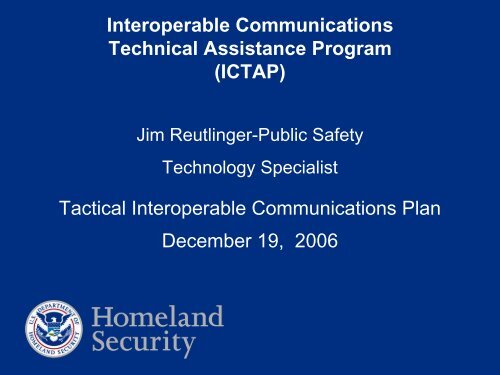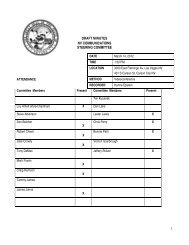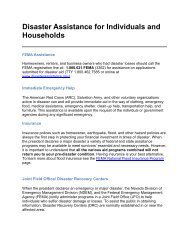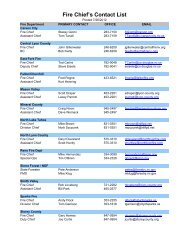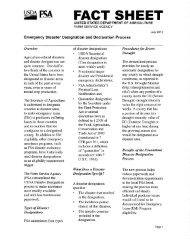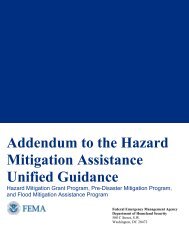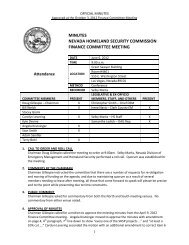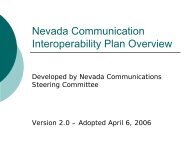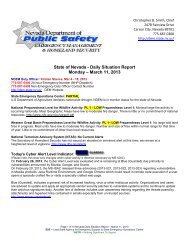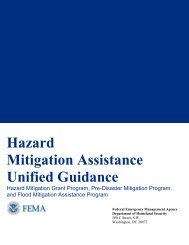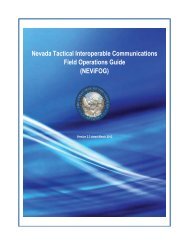Interoperable Communications Technical Assistance Program (ICTAP)
Interoperable Communications Technical Assistance Program (ICTAP)
Interoperable Communications Technical Assistance Program (ICTAP)
Create successful ePaper yourself
Turn your PDF publications into a flip-book with our unique Google optimized e-Paper software.
<strong>Interoperable</strong> <strong>Communications</strong><br />
<strong>Technical</strong> <strong>Assistance</strong> <strong>Program</strong><br />
(<strong>ICTAP</strong>)<br />
Jim Reutlinger-Public Safety<br />
Technology Specialist<br />
Tactical <strong>Interoperable</strong> <strong>Communications</strong> Plan<br />
December 19, 2006
Planning and Tools<br />
• Tactical <strong>Interoperable</strong> <strong>Communications</strong> Plan<br />
• <strong>Communications</strong> Asset System Mapping-CASM<br />
tool<br />
Office of State and Local Government and Preparedness
Tactical Interoperability<br />
(Elements)<br />
• Must be rapidly deployable at any time (24/7)<br />
• Should be fully operational within an hour of an<br />
incident occurring.<br />
• Requires oversight by trained <strong>Communications</strong><br />
Unit Leaders, as defined within the NIMS, to<br />
support equipment deployment.<br />
• May be provided through the use of common<br />
equipment (common channels, cached radios or<br />
shared systems) or a gateway between dissimilar<br />
systems and/or radio frequency bands.<br />
• Should always be in support of long-term<br />
interoperability by building upon or accelerating<br />
long-term strategies and efforts.<br />
Office of State and Local Government and Preparedness
Tactical Plan Components<br />
• Site Overview<br />
• Governance Structure<br />
• <strong>Interoperable</strong> Equipment<br />
• Equipment Policies and Procedures<br />
• Incident <strong>Communications</strong> Resource<br />
Plan<br />
•Based on Exercise Scenario<br />
• Trained <strong>Communications</strong> Unit Leaders<br />
Office of State and Local Government and Preparedness
Developing a Tactical Plan<br />
Collect<br />
Equipment<br />
Inventory Data<br />
Develop<br />
Governance<br />
Structure<br />
Develop Planned<br />
Allocation of<br />
<strong>Communications</strong><br />
Resources<br />
Draft<br />
Tactical<br />
Plan<br />
Conduct<br />
Gap<br />
Analysis<br />
(Time<br />
permitting)<br />
Finalize<br />
Tactical<br />
Plan<br />
Document /<br />
Develop<br />
Equipment<br />
Policies &<br />
Procedures<br />
Office of State and Local Government and Preparedness
Site Overview<br />
• Provide a brief overview of the metropolitan area and<br />
its efforts in addressing interoperable<br />
communications. Consider all communications<br />
interoperability goals and objectives included in the<br />
any strategic planning done prior. Any challenges<br />
faced to date with communications should also be<br />
included<br />
• List all agencies represented in the Tactical<br />
<strong>Interoperable</strong> <strong>Communications</strong> Plan.<br />
Office of State and Local Government and Preparedness
Governance Structure<br />
Operational Working Group:<br />
Responsible for determining<br />
operational and training requirements<br />
Steering Committee<br />
<strong>Technical</strong> Working Group:<br />
Responsible for identifying existing<br />
interoperable equipment and methods<br />
• Reviewing existing SOPs and apply as<br />
appropriate to anticipated incidents.<br />
• Developing formal written guidelines and<br />
checklists (SOPs), preferably by type of<br />
incident<br />
• Ensuring that SOPs and checklists follow<br />
ICS/NIMS standards.<br />
• Coordinating agency participating in NIMS<br />
Communication Unit Leader training.<br />
• Coordinating with <strong>Technical</strong> Working<br />
Group as appropriate to include technical<br />
guidelines and checklists into written<br />
plans.<br />
• Evaluating alternative solutions to<br />
address unmet needs for<br />
communications interoperability during<br />
potential incident types.<br />
• Reviewing potential solutions with the<br />
Operational Working Group to identify the<br />
most appropriate ones for anticipated<br />
types of incidents<br />
• Prepare solution recommendations and<br />
budgets for adoption by the Governance<br />
Group.<br />
Office of State and Local Government and Preparedness
<strong>Interoperable</strong> Equipment<br />
• Collect pertinent information on interoperable equipment<br />
• Cached Radios<br />
• Gateways<br />
• Shared Channels<br />
• Shared Systems<br />
• <strong>ICTAP</strong> can meet with agency POCs to confirm the<br />
required data have been have collected.<br />
• Following TICP development, data can be updated as<br />
needed to keep the plan current<br />
Office of State and Local Government and Preparedness
Equipment Policies<br />
& Procedures<br />
• Should be documented / developed for all interoperable equipment<br />
in the jurisdiction<br />
• Policies will address operational aspects such as:<br />
• Rules of Use<br />
• <strong>Interoperable</strong> <strong>Communications</strong> Request<br />
• Equipment Activation<br />
• Equipment Deactivation<br />
• Problem ID and Resolution<br />
• <strong>ICTAP</strong> can facilitate meetings to<br />
develop policies and provide examples<br />
from other agencies.<br />
Office of State and Local Government and Preparedness
Incident <strong>Communications</strong><br />
Resource Plan<br />
• Detail what method or specific interoperability resources will be<br />
used for multi-agency communications during an incident<br />
• Plan will address communications for the following specific ICS<br />
subdivisions<br />
• Incident Command and General Staff<br />
• Operations Section<br />
• Planning Section<br />
• Logistics Section<br />
• <strong>ICTAP</strong> can facilitate meetings to<br />
develop plan based on analysis<br />
of equipment lists and policies/<br />
procedures.<br />
Office of State and Local Government and Preparedness
Trained <strong>Communications</strong><br />
Unit Leaders<br />
• National Incident Management System (NIMS) - compliance<br />
• Currently only National Wildfire Coordinating Group (NWCG)<br />
training available for this function<br />
• All-hazards training under development by<br />
• Office of Grants and Training<br />
• SAFECOM<br />
• NIMS Integration Center<br />
Office of State and Local Government and Preparedness
SAFECOM Interoperability Continuum<br />
Office of State and Local Government and Preparedness
Interoperability Performance Measures<br />
Baseline Assessment<br />
Sub-Element<br />
Leadership<br />
Decision-making Groups<br />
Governance<br />
Standard Operating Procedures<br />
Technology<br />
Training and Exercises<br />
Usage<br />
Agreements<br />
Interoperability Funding<br />
Strategic Planning<br />
Policy, Practices, and<br />
Procedures<br />
Command and Control<br />
Approaches<br />
Implementation<br />
Maintenance and Support<br />
Operator Training<br />
Exercises<br />
Frequency of Use and<br />
Familiarity<br />
Office of State and Local Government and Preparedness
<strong>Interoperable</strong><br />
<strong>Communications</strong> <strong>Technical</strong><br />
<strong>Assistance</strong> <strong>Program</strong> <strong>ICTAP</strong><br />
Communication Asset<br />
Modeling Tool<br />
(CASM) Overview<br />
Office of State and Local Government and Preparedness
CASM Functionality<br />
• Inventory existing interoperable<br />
communications equipment,<br />
procedures, and capabilities<br />
• Map interoperable communications<br />
capabilities and methods<br />
• Conduct a communications gap<br />
analysis<br />
• Model current & proposed<br />
interoperable communications<br />
Needs Analysis<br />
Services<br />
Office of State and Local Government and Preparedness
CASM<br />
• USERS: 45 urban areas and states, and more than 730<br />
accounts, covering over 2,500 jurisdictions and 5,000 agencies<br />
at local, state and federal levels<br />
• IMPACT: One example is the aftermath of Hurricane Katrina.<br />
The data collected for CASM was the single readily available<br />
source of information on communications antenna towers.<br />
DURATION: Development of CASM began in August 2004; it<br />
was released for initial use July 18, 2005.<br />
Office of State and Local Government and Preparedness
Communication Asset System<br />
Mapping (CASM) Tool<br />
Developed For:<br />
• Urban Area<br />
• Spawar System Center - SD<br />
• Site Leads/Engineers & ODP<br />
Functionality<br />
•Ease of use<br />
•Display of Asset Inventory<br />
•Display Interoperability<br />
Office of State and Local Government and Preparedness
CASM – Features<br />
Features / Benefits:<br />
• Visualization of Agencies, Radio Systems and Tower<br />
locations for an Urban Area in a geographic map<br />
representation.<br />
• Agency icons reflect the highest level of interoperability<br />
they utilize.<br />
• Agency’s interoperability status uses the SafeCom<br />
Interoperability Continuum.<br />
• Swap radios, mutual aid channels, gateways, etc.<br />
Office of State and Local Government and Preparedness
CASM – Features<br />
Features / Benefits:<br />
• Pop-Up windows provide detailed information about<br />
agencies, radio systems, towers and interoperability for<br />
each icon.<br />
• Compatibility Tool shows communication<br />
interoperability between two selected agencies.<br />
• A pop-up window will identify the potential method(s)<br />
of interoperability.<br />
• UA Interoperability Matrix showing highest level of<br />
interoperability that is possible between all agencies in<br />
a matrix presentation.<br />
Office of State and Local Government and Preparedness
CASM – Purpose and Access<br />
Needs Addressed:<br />
• Inventory Display<br />
• Geophysically review radio system<br />
information<br />
• Quick view of Interoperability Status<br />
• Display of agency interoperability<br />
Office of State and Local Government and Preparedness
CASM – Purpose and Access<br />
Delivery Mechanism:<br />
• Web-enabled Application<br />
• Application downloads to user<br />
• Requires an internet connection<br />
• Application connects to SSC-SD<br />
• Database and map server at SSC-SD<br />
• Requires user ID and password<br />
• Standalone PC version is also being<br />
considered/evaluated<br />
Office of State and Local Government and Preparedness
CASM – Initial View<br />
Map Layer<br />
and Tool<br />
Options<br />
Agency<br />
Icon<br />
Legend<br />
Map Context<br />
Reference<br />
(when using<br />
Zoom<br />
Feature)<br />
Cursor<br />
Position<br />
Office of State and Local Government and Preparedness
CASM – Agency Detail<br />
Agency Layer<br />
(Default)<br />
Cursor select Agency Icon,<br />
and Detail Information<br />
Popup appears.<br />
Bolded info can be<br />
selected to launch<br />
additional Info Popups.<br />
Office of State and Local Government and Preparedness
CASM – Agency Detail Pop-up<br />
(Interoperability Methods Info)<br />
‘Interoperability Methods<br />
Currently in Use<br />
selected to launch<br />
popup.<br />
Interoperability Methods’ listed in<br />
order of Interoperability Continuum<br />
hierarchy. Systems in use by<br />
Agency are listed next to IC Method.<br />
Office of State and Local Government and Preparedness
CASM – Agency Detail Pop-ups<br />
(Radio System and Tower Info)<br />
Radio System Detail<br />
Popup with scroll to<br />
view all data.<br />
Select Radio<br />
System<br />
Office of State and Local Government and Preparedness
CASM – Tower View<br />
Displays tower locations<br />
Tower<br />
Layer<br />
Tower Icon<br />
Office of State and Local Government and Preparedness
CASM – Tower Detail Pop-up<br />
Select Tower Icon<br />
and Tower Detail<br />
Popup appears.<br />
Office of State and Local Government and Preparedness
CASM – Radio Systems View<br />
Radio System<br />
Layer<br />
Radio<br />
System<br />
Icon<br />
Legend<br />
Office of State and Local Government and Preparedness
CASM – Radio System Detail Pop-Up<br />
Select Radio System<br />
Icon and Radio<br />
System Detail Popup<br />
appears.<br />
Select Individual Radio<br />
System Tower and Tower<br />
Detail Popup will appear.<br />
Office of State and Local Government and Preparedness
CASM – Interoperability View<br />
Interoperability<br />
Layer<br />
Color Displayed is for the<br />
Highest Level of<br />
Interoperability used by<br />
Agency.<br />
Interoperability<br />
Continuum Icon<br />
Legend<br />
Office of State and Local Government and Preparedness
CASM – Compatibility<br />
Matrix (Selection)<br />
Access the<br />
Compatibility<br />
Matrix from the<br />
‘File’ Menu.<br />
Office of State and Local Government and Preparedness
CASM – Compatibility Matrix<br />
When<br />
Compatibility<br />
Matrix is selected<br />
from the File<br />
Menu, the Matrix<br />
window appears<br />
showing level of<br />
compatibility<br />
between Agencies.<br />
The Urban Area<br />
Agencies appear<br />
on both top and<br />
side.<br />
The details of the<br />
Inter-Agency<br />
Interoperability can<br />
be viewed if you<br />
select the<br />
intersecting cell.<br />
Office of State and Local Government and Preparedness<br />
The Intersection<br />
of agency rows<br />
is color coded<br />
according to the<br />
level of<br />
interoperability<br />
between<br />
agencies (see<br />
the<br />
Interoperability<br />
Legend on the<br />
Map).<br />
Shown here are:<br />
Blue -<br />
Proprietary<br />
Grey - Gateway<br />
Yellow - Shared<br />
Channels<br />
Red – No<br />
Interoperability<br />
White -<br />
intersection of<br />
agency with<br />
itself.
Questions/Comments?<br />
•Thank you<br />
Office of State and Local Government and Preparedness


